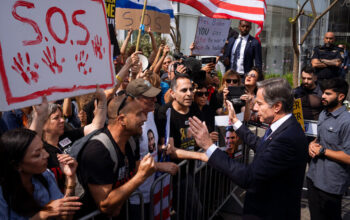
ROME — Letizia Battaglia, a photographer who chronicled years of Sicilian Mafia bloodshed in Palermo, Italy, in unflinching images that became ingrained in the national consciousness, died on Wednesday at her home in Palermo. She was 87.
Her daughter Patrizia Stagnitta confirmed her death but did not specify the cause.
“Mario Puzo wrote a book about the Mafia. Coppola made a film. But only Letizia Battaglia tells of the true story and its harsh reality” said the blurb for Anthology, an art book of her photographs that grew out of a 2016 exhibition of her work in Palermo, the capital of Sicily.
Ms. Battaglia went to work for the Palermo newspaper L’Ora in the 1970s, during the turbulent years known as the second Mafia Wars, when mobsters from the town of Corleone muscled in on Palermo crime gangs.
The gangland war felled hundreds of Mafiosi but also law enforcement officers, prosecutors and politicians. Ms. Battaglia and the photographer Franco Zecchin, her companion in life, were often first on the scene because they had an illegal police scanner.
One of her best-known images, taken on Jan. 6, 1980, depicted the corpse of Piersanti Mattarella, the governor of Sicily, being held by his brother Sergio, who today is the president of Italy.
Even as she recorded those killings, Ms. Battaglia openly challenged the grip the Mafia had on Sicily. In 1979, she gathered photographs of victims and set them up in the main square of Corleone, the hometown of Sicily’s most ruthless crime family at the time. It was a bold and potentially dangerous move.
“Her photos were an act of condemnation,” Paolo Falcone, the curator of several recent exhibitions of her work, said in a 2017 interview with The New York Times for a Saturday Profile of Ms. Battaglia. “She was a photographer, but more so an activist.”
Other photographs of the Mafia were exhibited on the streets of Palermo. “I was afraid,” she acknowledged to The Times, adding that she couldn’t count the number of times she had received threats by phone or had been harassed on the street. Once, she received an anonymous letter telling her to leave Palermo for good. “Your sentence has already been decreed,” she said it read.
The threats hardened her determination to make a difference. She became a leader of the so-called “Palermo Spring” in the mid-1980s, when ordinary people began to denounce the Mafia openly.
Ms. Battaglia later detoured into politics, winning a seat on Palermo’s City Council and then in the regional parliament.
Letizia Battaglia was born on March 5, 1935, in Palermo. Her father, a sailor, took the family to Trieste in northern Italy, where she spent her infancy before returning to Palermo. Her mother was a homemaker.
Ms. Battaglia married at 16 and had three daughters by her mid-20s.
In 1971, she left her husband and moved to Milan, where she began working as a journalist. Her career in photojournalism began after editors encouraged her to photograph the subjects of her articles. She taught herself how to use a camera, inspired by photographers she admired, like Mary Ellen Mark, Josef Koudelka, and especially Diane Arbus, whom she met in the 1980s.
She returned to Palermo in 1974, just shy of her 40th birthday.
Best known for the photographs she took when she worked the crime beat for L’Ora from 1974 to 1992, Ms. Battaglia was also drawn to social issues. Her subjects included the patients of a psychiatric hospital, the island’s poor, the challenging lives of women and young girls growing up in Sicily, and especially her city, Palermo.
“Palermo has lost an extraordinary woman,” Mayor Leoluca Orlando wrote on the city’s official website. “Letizia Battaglia was an internationally recognized symbol in the world of art, and a banner in Palermo’s liberation from the rule of the Mafia.”
In her later years she was celebrated in exhibitions in major museums and in art books filled with images culled from an archive of some 600,000 photographs.
“I never thought of myself as an artist, and I am still astonished to enter into a museum and see my work,” Ms. Battaglia said in the 2017 Times interview.
She first received international recognition in 1985, when she received the W. Eugene Smith Grant for humanistic photography, given by the W. Eugene Smith Memorial Fund in New York.
In more recent years Ms. Battaglia helped create Palermo’s first museum dedicated to photography, the Centro Internazionale della Fotografia, which opened in 2017.
On Friday, Mayor Orlando announced that the center would be renamed in her honor, as would a street in a Palermo cultural center.
A television mini-series about her life, “Just for Passion: Letizia Battaglia, Photographer,” will be broadcast in Italy next month. “She had a very adventurous life,” the director, Roberto Andò, said in a telephone interview. “I am just sorry that I wasn’t able to show it to her.”
Besides her daughter Patrizia, she is survived by two other daughters, Cinzia Stagnitta and Shobha Battaglia, who is also a photographer; five grandchildren; and four great-grandchildren.
Ms. Stagnitta said in a telephone interview that her mother had continued to work despite difficulties walking. In the week before her death Ms. Battaglia participated in a workshop in central Italy, and earlier this year she photographed a young Italian singer for a weekly magazine.
“She was still working, earning her daily bread,” Ms. Stagnitta said.



